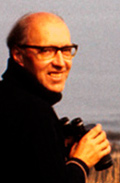
|
|
|
Dick's life with physics, page 6 |
|
|
|
|
|
About this time Dick explored the possibility of enhancing the students' experience with short films. He and David Vass went to the Calton Studios one day. Without any opportunity for rehearsal or re-takes, David presented an experiment from the second year laboratory and Dick made a separate film introducing its theory. These were used for several years, but their cost effectiveness did not merit further productions. Catherine Woods had come to Edinburgh with a Masters degree from Galway, with a view to doing a PhD; before her thesis was complete she married Peter Farago's student, and later collaborator, John Wykes. Dick suggested she use a Kerr cell in an experiment to look for a predicted effect about which there was some controversy. In 1956 Hungarians Jánossy and Nagy had suggested an optical experiment in which the two paths of an interferometer would be alternately occulted by a shutter - say a shutter which oscillated so that it always blocked one path or the other, but never both. They questioned whether interference would take place in such a case, and indeed it does at first sight appear that the necessary condition for interference - that there should be no way of knowing along which path the light detected at a given instant has come - is not satisfied. However Mandel showed in 1959, on the basis of classical coherence theory, that an interference pattern should be expected provided that the mean interval between successive openings of either beam is less than the coherence time of the light; the visibility envelope, however, would not be the same as in the absence of the shutter. The Sillitto-Wykes experiment was completely successful. Dick was pleased to contribute a paper about this experiment, New Light on Optical Interference, to the 1971/72 Festschrift edition of Proceedings 'A' of the Royal Society of Edinburgh in honour of Norman Feather's 25-year period in the Chair of Natural Philosophy. Another of the 30 or so contributors was a young lecturer, G M Thomas, who had joined the department in 1959 after a spell with the British Antarctic Survey Gwynne attended the Quantum Optics Summer School, and thereafter spent much time in discussion with Dick. His elegant paper, The Zeros of the Optical Coherence Functions and their Utility in the Study of Spectra, was not concerned with rigorous mathematics, but rather concentrated on "explaining to the experimentalist how a knowledge of these zeros can help him extract from his measurements the fullest possible information". Sadly, Gwynne developed a nerve-wasting disease soon after the department's move to Kings Buildings, and he died in 1973. At the suggestion of post-doc Mary McCann, his colleagues planted a tree in his memory at the back of their new James Clerk Maxwell building. 1971 had seen the start of the move to KB, though first and second year classes would continue in Drummond Street and the Appleton Tower until 1974. Peter and Dick now had separate offices and a number of laboratories in the new building. Dick received support from the Ministry of Defence for a study of the evaluation and optimisation of optical imaging in partially coherent light. This was suggested by Norman Davidson, the man who had recruited Nigel Haig three years earlier. Funding was provided for a graduate student. Advertisements produced only one applicant with the necessary background in both optics and computing, American Eric Kintner fresh from coursework for an astronomy PhD in Maryland. To appoint him special dispensation had to be obtained, on the grounds that there was no-one in the UK who could do the work. Professor Feather referred to Eric as "Dick's mail-order student". His 4 years' work for a PhD was very productive. He developed a new performance indicator to gauge the tendency of a system to produce edge-ringing, and a new analytic method for computing the Optical Transfer Function. The facilities of the Edinburgh Regional Computing Centre in the same building were vital to this success. Some of the equipment of the Sillitto-Haig experiment was transferred to one of the new labs; Winifred Sillitto re-assembled it in a light-tight box made in the new departmental workshop, and re-designed the coincidence counting circuitry, before handing it over to postgraduate student Joan McMillan. Joan was able to produce the long-expected results for two different wavelengths of the mercury discharge. Winifred, prompted by a problem raised by a student in the laboratory where she was a demonstrator, started on a series of computer-based simulations and experimental investigations using laser light, of classical Fraunhofer diffraction at regular polygonal apertures, creating projects for final year students. This tied up with Dick's interest in the symmetry properties of the Zernike polynomials in relation to lens aberrations, on which he was working with Eric. In September 1974 Dick had a brief visit from Monash University's Gordon Troup who, with his colleague R G Turner, had just prepared a review of optical coherence for Reports on Progress in Physics: Shortly afterwards Robin Turner came to Edinburgh on a year's sabbatical, and worked on the Shifts of coherent light beams on reflection at plane interfaces between isotropic media. A younger man came from Monash, too. Ian Every arrived on a cold wet night in Jan 1975 to spend two and a half post-doctoral years, some of the time thinking about the very controversial Schwarz-Hora effect. He then joined the Open University where he continues to develop the interactive use of computers to help students learn. |



|
| Site index |